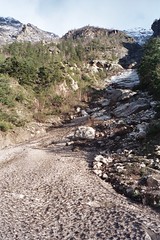
This quote from the New York Times science article (free subscription required) makes the case for reporting it in Climate Frog:
The thousands of glaciers studded across 1,500 miles of the Himalayas make up the savings account of South Asia’s water supply, feeding more than a dozen major rivers and sustaining a billion people downstream. Their apparent retreat threatens to bear heavily on everything from the region’s drinking water supply to agricultural production to disease and floods.The glaciers of the Himalaya, which feed the rivers that flow through India, are among the least studied glaciers in the world. There is little history of their growth and shrinkage to refer to in evaluating trends, but since all glaciers in all parts of the world have been in major retreat for the past 20 years, it's safe to assume that the same is true in the Himalaya. The difference here is that a huge population- over a billion people - is dependent on the water that has historically been released through the dry season by the gradual melting of these accumulations of ice.
As the article says, the IPCC addresses the shrinking glacier problem in its recently released report.
In its report, the international panel predicted that as these glaciers melt, they would increase the likelihood of flooding over the next three decades and then, as they recede, dry up the rivers that they feed. “In the course of the century,” it warned darkly, “water supply stored in glaciers and snow cover are projected to decline, reducing water availability in regions supplied by meltwater from major mountain ranges, where more than one-sixth of the world population currently lives.”


1 comment:
Post a Comment